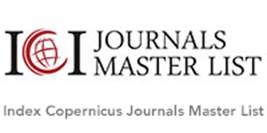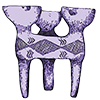A Comparative Examination of the Matriarchal Elements in the Epic of Koroghlu
DOI:
https://doi.org/10.33831/jws.v21i2.158Keywords:
Epic of Koroghlu, Hieros Gamos, Ritual Sacrifice, Matriarchy, Minstrelsy TraditionAbstract
This study aims to shed light on the matriarchal past of Turkish culture by revealing the matriarchal elements in the Epic of Koroghlu. As well as these elements are the ones we can see as the traces of matriarchal culture such as tomb, spring, blindness, pomegranate and apple, they are also related to the rituals of the sacrifice of a god/king and sacred marriage which we can see in many cultures. The existence of such phenomena in different cultures enables us to complete the missing pieces by comparing them. Therefore, such a comparison has also been made in the present study to comprehend the matriarchal elements in the Epic of Koroghlu better.
References
Baring, A. ve Jules C. (1993). The Myth of the Goddess: Evolution of an Image. London: Penguin Books.
Bayat, F. (2003). Köroğlu. Ankara: Akçağ Yayınları.
Bayat, F. (2005). Ay Kültünün Dini-Mitolojik Sisteminde Türk Boy Adlarının Etimolojisi. Ankara: Üç Ok Yayınları.
Bayat, F. (2006). Ana Hatlarıyla Türk Şamanlığı. İstanbul: Ötüken Yayınları.
Bayat, F. (2007). Türk Mitolojik Sistemi: Ontolojik Ve Epistemolojik Bağlamında Türk Mitolojisi c. 1. İstanbul: Ötüken Neşriyat.
Blackledge, C. (2004). The Story of V: A Natural History of Female Sexuality. New Jersey: Rutgers University Press.
Brockway, L. Sue. (2008). The Goddess Pages: A Divine Guide to Finding Love & Happiness. Minnesota: Llewellyn Publications.
Cameron, D. O. (1981). Symbols of birth and of death in the Neolithic era. London: Kenyon-Deane.
Campbell, J. (2006). İlkel Mitoloji. (çev. Kudret Emiroğlu). Ankara: İmge Kitabevi.
Crumpacker, B. (2007). The Sex Life of Food: When Body and Soul Meet to Eat. New York: St. Martin’s Press.
Davidson, H. Ellis. (2001). Roles of the Northern Goddess. New York: Taylor & Francis.
Eliade, M. (2002). Babil Simyası ve Kozmolojisi. (çev. Mehmet Emin Özcan). İstanbul: Kabalcı Yayınları.
Eliade, M. (2003). Demirciler ve Simyacılar. (çev. Mehmet Emin Özcan). İstanbul: Kabalcı Yayınları.
Frazer, J. George (1911). Golden Bough: A Study in Magic and Religion, Part 3: The Dying God, third edition. London: Macmillan and Co.
Gimbutas, M. (2001). The Living Goddess. California: University of California Press.
Graves, R. (2010). The White Goddess: A Historical Grammar of Poetic Myth. London: Faber and Faber.
Grimm, J. ve Wilhelm G. (2003). The Complete Fairy Tales of the Brothers Grimm. (çev. Jack Zipes). New York: Bantam Books.
Günay, U. (2008). Türkiye’de Âşık Tarzı Şiir Geleneği ve Rüya Motifi. Ankara: Akçağ Yayınları.
İnan, A. (2006). Tarihte ve Bugün Şamanizm: Materyaller ve Araştırmalar. Ankara: Türk Tarih Kurumu Yayınları.
Levy-Bruhl, L. (2006). İlkel Toplumlarda Mistik Deneyim ve Simgeler. (çev. Oğuz Adanır). Ankara: Doğu Batı Yayınları.
Meyer, M. Wayne. (1999). The ancient Mysteries: A sourcebook of Sacred Texts. Pennsylvania: University of Pennsylvania Press.
Ögel, B. (2002). Türk Mitolojisi c. 2. Ankara: Türk Tarih Kurumu Yayınları.
Reed, E. (1995). Kadının Evrimi: Anaerkil Klandan Ataerkil Aileye c. 1. (çev. Şemsa Yeğin). İstanbul: Payel Yayınları.
Ruck, C. A. Paul. (2006). Sacred Mushrooms of the Goddess. California: Ronin Publishing.
Sjöö, M. (1987). The Great Cosmic Mother: Rediscovering the Religion of the Earth. New York: HarperCollins Publishers.
The American Heritage Dictionary of the English Language (2006). Boston: Houghton Mifflin Harcourt, Fourth Edition.
Tram-Semen, S. (2008). Nart Boyu Türkleri Hun-Karaçaylıların Mitolojisi. (çev. Aras Sözüer). İstanbul: Kaynak Yayınları.
Walker, B. G. (1983). The Woman’s Encyclopedia of Myths and Secrets. New York: HarperCollins.
Downloads
Published
How to Cite
Issue
Section
License
Authors who publish with this journal agree to the following terms:
- Authors retain copyright and grant the journal right of first publication, with the work [6 months] after publication simultaneously licensed under a Creative Commons Attribution License that allows others to share the work with an acknowledgement of the work's authorship and initial publication in this journal.
- Authors are able to enter into separate, additional contractual arrangements for the non-exclusive distribution of the journal's published version of the work (e.g., post it to an institutional repository or publish it in a book), with an acknowledgement of its initial publication in this journal.
- Authors are permitted and encouraged to post their work online (e.g., in institutional repositories or on their website) prior to and during the submission process, as it can lead to productive exchanges, as well as earlier and greater citation of published work (See The Effect of Open Access)







